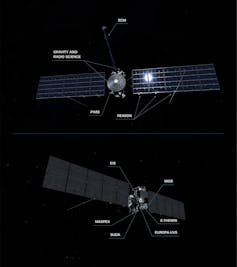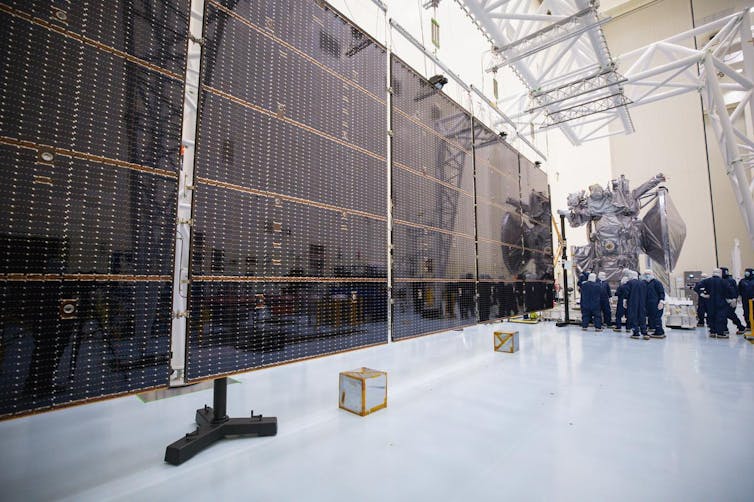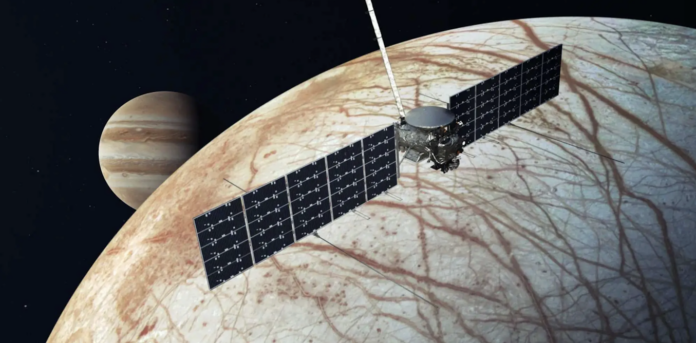NASA is preparing to launch Europa Clipper to Europa, one of Jupiter’s icy moons, which most likely harbors an ocean beneath its icy surface. The mission aims to study the “habitability” of the moon Europa.
The icy moons of the outer planets of the solar system continue to surprise scientists. And firstly because they force us to extend the notion of “habitability” – the conditions which could allow life, as we know it, to hatch.
It is to study one of these moons that the Europa Clipper mission is scheduled to take off on October 12 from Cape Canaveral in Florida, United States – from the historic launch pad 39A which notably saw the Apollo missions take off, to reach one of Jupiter’s moons, called Europa.
The icy moons of the outer planets redefine the notion of “habitability zone”
Traditionally, the “habitable” zone is defined as an interval of distance from the star where liquid water could exist stably on the surface. Too close to the star, it is too hot and the water is in the form of vapor. Too far from the star, it is too cold and the water is in the form of ice. Thus, in our own solar system, only Earth and Mars are in the “habitable zone” (even if, on Mars, liquid water is not possible on the surface because of too low atmospheric pressure).
So “habitable”does not mean inhabited in any way but determines the minimum conditions for a form of life similar to the one we know to develop and maintain itself.
But with the exploration of the outer solar system, and in particular the systems of Jupiter and Saturn, scientists have had to question the relevance of this definition, particularly with the possibility of large amounts of liquid water deep in the moons.
Indeed, NASA’s Galileo mission made it possible to discover in the 1990s with surprise on Europe, Ganymede and Callistotwo icy moons of Jupiter, the probable presence of oceans of liquid and salty water, hidden under their thick icy crusts (several tens of kilometers).
NASA/JPL-Caltech
A decade later, it was the Cassini-Huygens mission that revealed intriguing characteristics of Saturn’s icy moons: Titan and Enceladus would have internal oceans of liquid water, partly revealed by surface activities, like the geysers escaping from faults, called “tiger claws” on Enceladus. And this year, it is Mimas, another small moon of Saturn, which has been in the spotlight with a very precise study of its orbit which suggests the presence of an ocean under its surface.
These discoveries made it possible to extend this notion of “habitable zone” to possible environments under the surface of planetary bodies.
On all these icy moons, the presence of liquid water is due to the heat produced by tidal effects which deform the bodies at depth and cause them to heat up. These effects can be very strong because all these moons orbit close to very massive gas giants.
Thus, the main objective of Europa Clipper is to determine the “habitability” of the subglacial ocean of Europe, that is to say to confirm the presence of a global ocean, which could contain twice as many water than all the Earth’s oceans combined. It also involves determining its salinity, its composition, its temperature and its potential links with the surface.
Europa Clipper’s eyes
Europa Clipper is equipped with nine scientific instruments, each of them designed to provide essential information about Jupiter’s moon in different areas.

NASA/JPL-Caltech
Four instruments are particularly important for imaging the surface of Europa to better describe and understand its characteristics.
To map Europe in wide field and high resolution, these are the two complementary cameras of the Europa Imaging System which will come into action. Their data will also make it possible to determine the topography of Europe.
The chemical composition of the surface will be analyzed by spectrometers which will identify the atoms and molecules present on the surface. The first, in the near infrared (MISE for Mapping Imaging Spectrometer for Europa) will be able in particular to map the presence of salts. The second, in the ultraviolet (Europa Ultraviolet Spectrograph) will be particularly useful for researching geysers.
The E-THEMIS thermal imager (Europa Thermal Emission Imaging System) will make it possible to estimate the temperature remotely to detect hot spots, possible signs of geological activity under the surface.
To probe Europa’s icy crust in depth and understand its dynamics, and in particular its exchanges with the underlying ocean, Europa Clipper also carries the REASON radar (Radar for Europa Assessment and Sounding: Ocean to Near-surface) designed to penetrate the ice and reveal the internal structure of the moon’s upper layers. In particular, it should make it possible to detect pockets of liquid water at different depths, perhaps even the ice-ocean transition, and provide crucial data on the thickness of the ice and the nature of the underlying ocean.
Fly over Europe up close
The last four instruments on board Europa Clipper are intended for what we call “in-situ” measurements, which allow them to measure their environment directly, where they are.
In particular, during low flybys, less than 100 kilometers from the surface, two instruments will analyze the density and chemical composition of particles ejected from the surface by impacts or by potential geysers, of which we currently only have indirect indications. Thus, the mass spectrometer (MAss Spectrometer for Planetary EXploration/Europa) will analyze the very thin “atmosphere” of Europe (in reality an “exosphere” at a pressure of 10-12 bar, or 1,000 billion times less than on Earth) and the analyzer (SURFAE Dust Analyzer) dust.
The probe also carries a magnetometer (Europa Clipper Magnetometer) to measure disturbances in the magnetic field around Europa. These disturbances can notably inform us about the composition of the ocean. In addition, gravity measurements by the probe’s radio system will make it possible to analyze the effects of gigantic tides exerted by Jupiter on Europa. Understanding how tidal forces affect Europa will allow us to better constrain the internal structure of the moon and in particular the depth of the ocean.
Finally, PIMS (Plasma Instrument for Magnetic Sounding) will measure the characteristics of charged particles in Jupiter’s environment (called plasma), as well as the bombardment of particles arriving at the surface. Indeed, a salty ocean produces an induced magnetic field in reaction to Jupiter’s magnetic field and the plasma will allow us to precisely characterize these magnetic fields.
On the way to Jupiter…
A busy program therefore awaits Europa Clipper but the probe is solidly equipped to determine by 2030 the habitability of one of the most intriguing bodies in the solar system.

NASA/Kim Shiflett
Europa Clipper will join its big sister Juice (Jupiter Icy Moons Explorer) from the European Space Agency (ESA) launched in April 2023 from Kourou, French Guiana. While Europa Clipper will focus on Europa, Juice will explore the entire Jupiter system with a particular interest in its icy moons and will eventually orbit its largest moon, Ganymede.
These joint missions illustrate the competition, but above all the strong international cooperation in the field of space exploration. For the first time, two missions will explore the same system at the same time, offering scientists from several generations a unique opportunity to understand these distant worlds.

This article is published as part of the Science Festival (which takes place from October 4 to 14, 2024), and of which The Conversation France is a partner. This new edition focuses on the theme “ocean of knowledge”. Find all the events in your region on the site Fetedelascience.fr.

